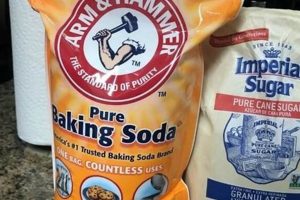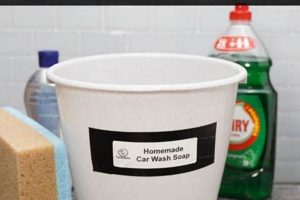Astringent liquids crafted at home for facial application, intended to cleanse and balance skin pH, represent a growing area of interest within personal skincare. These preparations often incorporate readily available ingredients like botanical extracts, vinegars, or teas, customized to address specific dermatological needs. A typical example involves combining green tea infusion with apple cider vinegar and a few drops of essential oil for oily skin.
The significance of these homemade formulations lies in their potential for cost-effectiveness, control over ingredients, and avoidance of harsh chemicals commonly found in commercially produced alternatives. Historically, plant-based tonics were a cornerstone of skincare routines before the advent of mass-produced cosmetics, reflecting a reliance on natural resources and individualized approaches to beauty.
The following discussion will delve into the selection of appropriate components, formulation techniques, safety considerations, and efficacy evaluations associated with creating skin-balancing solutions. Furthermore, it will examine methods for storage and application to maximize benefits while minimizing potential adverse effects.
Formulating Homemade Skin Tonics
Achieving optimal results with homemade skin tonics necessitates careful consideration of ingredient selection, formulation techniques, and safety protocols. The following recommendations provide guidance for creating effective and safe preparations.
Tip 1: Ingredient Sourcing and Quality. Prioritize the use of high-quality ingredients. Opt for organic botanical extracts and unrefined vinegars to minimize potential contaminants. The source and purity of each component directly influences the efficacy and safety of the final product.
Tip 2: pH Level Monitoring. Accurate pH measurement is critical. The skin’s natural pH is slightly acidic (around 5.5). Ensure the finished product aligns with this range, utilizing pH strips or a digital meter. An imbalance can lead to irritation or disruption of the skin’s protective barrier.
Tip 3: Patch Testing Implementation. Before applying a new formulation to the entire face, conduct a patch test on a small, discreet area of skin, such as the inner arm. Observe for any adverse reactions, including redness, itching, or irritation, over a 24-hour period.
Tip 4: Proper Dilution Ratios. Adhere to recommended dilution ratios, particularly when working with potent ingredients like essential oils or concentrated vinegars. Excessive concentrations can cause skin sensitivity or even chemical burns. A general guideline for essential oils is 1-2% dilution in a carrier liquid.
Tip 5: Sterilization of Equipment and Storage. Thoroughly sterilize all equipment, including mixing bowls, utensils, and storage containers, before use. Store finished products in airtight, dark-colored glass bottles in a cool, dry place to prevent oxidation and microbial contamination. Discard after a specified period (typically 1-2 months) to ensure freshness and safety.
Tip 6: Consideration of Skin Type. Tailor formulations to individual skin types. Oily skin may benefit from astringent ingredients like witch hazel or apple cider vinegar, while dry or sensitive skin may require more hydrating and soothing components such as aloe vera or rosewater.
The implementation of these strategies contributes to the creation of efficacious and secure homemade skin balancing solutions. Attention to ingredient quality, pH balance, and safety precautions is paramount.
The subsequent section will explore specific formulations appropriate for various dermatological conditions, accompanied by detailed instructions and considerations.
1. Ingredient Quality
Ingredient quality is a foundational determinant in the efficacy and safety of skin balancing solutions crafted at home. The selection of superior components directly correlates with the potential benefits and minimizes the risk of adverse reactions. Consequently, a comprehensive understanding of ingredient sourcing and properties is crucial.
- Purity and Contamination
The presence of contaminants in raw materials, such as pesticides in botanicals or heavy metals in mineral components, can negate the intended benefits. Organic certification and third-party testing provide assurances of purity. The use of contaminated ingredients may induce skin irritation, allergic reactions, or long-term dermatological complications.
- Bioavailability of Active Compounds
The concentration and form of active compounds within ingredients influence their bioavailability, or the extent to which they are absorbed and utilized by the skin. For example, using a low-grade aloe vera gel with limited polysaccharide content will yield diminished soothing and hydrating effects compared to a high-quality extract with a standardized concentration of bioactive compounds. The selection should be determined by this reason.
- Potential for Irritation and Allergies
Certain ingredients possess a higher propensity for causing irritation or allergic reactions. Synthetic fragrances, harsh preservatives, and improperly processed plant extracts are common culprits. Identifying individual sensitivities through patch testing is paramount, but selecting ingredients with a low allergenic profile from the outset minimizes the risk of adverse events. For example, witch hazel with a high alcohol content is more likely to irritate sensitive skin.
- Stability and Shelf Life
Ingredient quality impacts the stability and shelf life of the final product. Inferior-quality oils may oxidize more rapidly, leading to rancidity and decreased efficacy. Similarly, unstable preservatives may fail to adequately protect against microbial contamination. Consequently, the utilization of high-quality, stable ingredients contributes to a longer shelf life and sustained potency.
In conclusion, the pursuit of effective and safe homemade skin balancing solutions necessitates a rigorous focus on ingredient quality. From minimizing contamination and maximizing bioavailability to mitigating irritation risks and ensuring product stability, the selection of superior components is a cornerstone of responsible formulation. These components determine the whole quality of a formula.
2. pH Balance
pH balance is a critical parameter in the formulation and efficacy of homemade skin tonics. The skin’s acid mantle, a protective barrier composed of sebum and sweat, maintains a slightly acidic pH, typically ranging from 4.5 to 5.5. This acidity inhibits the growth of harmful bacteria, supports the skin’s natural enzymatic functions, and contributes to overall skin health. Imbalances in pH, whether leaning towards excessive acidity or alkalinity, can disrupt the skin’s barrier function, leading to dryness, irritation, inflammation, and increased suscep
tibility to infections. In the context of do-it-yourself formulations, improper pH adjustment poses a significant risk. For instance, tonics with an excessively alkaline pH, resulting from the inclusion of ingredients like baking soda without proper buffering, can strip the skin of its natural oils, causing dehydration and irritation. Conversely, tonics with a pH that is too acidic, often due to an overabundance of ingredients such as undiluted lemon juice or vinegar, can cause chemical burns and compromise the skin’s integrity.
The practical significance of understanding pH in the context of creating skin balancing solutions lies in the ability to tailor formulations to support the skin’s natural acid mantle. Incorporating pH-adjusting agents, such as citric acid or lactic acid, allows for fine-tuning the formulation to achieve an optimal pH range. Measuring the pH of the finished product using pH strips or a digital pH meter is essential. Further, the choice of ingredients themselves plays a role. For example, incorporating aloe vera juice, which has a naturally acidic pH, can contribute to a more balanced formulation. Alternatively, incorporating botanical extracts requires an understanding of their inherent pH to ensure compatibility with the target range. Real-world examples highlight the detrimental effects of neglecting pH: the widespread use of highly alkaline soaps in the past led to chronic skin dryness and irritation until the importance of pH-balanced cleansers was recognized. Similarly, in homemade formulations, ignoring pH can lead to unintended consequences, such as exacerbating existing skin conditions or creating new dermatological problems.
In summary, maintaining an appropriate pH is paramount for the safety and effectiveness of skin balancing solutions prepared at home. Disruptions to the skin’s natural acid mantle can lead to various adverse effects, underscoring the need for meticulous pH adjustment and monitoring during formulation. The challenges associated with achieving precise pH balance in DIY formulations can be mitigated through careful ingredient selection, the use of pH-adjusting agents, and routine pH measurement. Prioritizing pH balance in skin balancing solutions is not merely a cosmetic consideration but a fundamental aspect of supporting skin health and preventing dermatological complications.
3. Skin Type
The dermatological profile, encompassing factors such as sebum production, hydration levels, and sensitivity thresholds, critically influences the formulation and efficacy of homemade skin balancing solutions. Tailoring these solutions to specific skin types minimizes adverse reactions and maximizes therapeutic benefits.
- Oily Skin
Characterized by excessive sebum secretion, oily skin necessitates astringent and oil-controlling ingredients. Formulations may incorporate witch hazel, known for its ability to constrict pores and reduce oil production, or diluted apple cider vinegar, which aids in balancing pH and removing excess sebum. Overuse of astringents, however, can lead to reactive sebum production, necessitating careful titration of ingredient concentrations. Examples of appropriate components for this skin type include tea tree oil (at low concentrations due to its potency) and lemon juice (also diluted due to its acidity).
- Dry Skin
Dry skin exhibits a deficiency in natural moisturizing factors and lipid content, requiring humectants and emollients to replenish hydration. Glycerin, a potent humectant, attracts moisture from the environment, while rosewater provides mild hydration and soothes irritation. The inclusion of occlusive agents, such as plant-based oils (e.g., jojoba or argan oil), can further prevent moisture loss. Formulations should avoid alcohol-based ingredients, which exacerbate dryness. Proper ingredient selection is extremely important.
- Sensitive Skin
High reactivity to irritants characterizes sensitive skin, necessitating formulations with soothing and anti-inflammatory properties. Aloe vera, chamomile, and calendula extracts possess calming effects and reduce inflammation. Prioritization of hypoallergenic ingredients and the exclusion of synthetic fragrances, dyes, and preservatives are paramount. Patch testing before widespread application is mandatory to ascertain tolerance. Colloidal oatmeal is an example of skin friendly ingredient.
- Combination Skin
Exhibiting both oily and dry regions, combination skin requires a balanced approach. Formulations should target oil control in the T-zone (forehead, nose, and chin) while providing adequate hydration to drier areas. Gentle toners incorporating ingredients such as green tea extract, known for its antioxidant and anti-inflammatory properties, can be beneficial. Selective application to specific areas of the face, rather than overall application, may be necessary. The key is balance.
The customization of formulations based on dermatological profiles is essential for optimizing the benefits and minimizing the potential risks associated with homemade skin balancing solutions. A comprehensive understanding of individual skin characteristics and ingredient properties enables the creation of effective and safe preparations that cater to unique needs. Each formula should have consideration.
4. Safety Testing
Safety testing, in the context of homemade skin balancing solutions, constitutes a crucial step in mitigating potential adverse reactions and ensuring the well-being of individuals utilizing these formulations. Due to the variability in ingredient quality, formulation techniques, and individual sensitivities, a systematic approach to safety assessment is imperative before widespread application.
- Patch Testing Protocol
Patch testing involves the application of a small quantity of the finished product to a discrete area of skin, typically the inner forearm or behind the ear, for a defined period (24-48 hours). This protocol allows for the observation of localized reactions, such as erythema, pruritus, edema, or vesiculation. A positive reaction necessitates the discontinuation of product use. The absence of a reaction, however, does not guarantee the absence of delayed hypersensitivity or systemic effects.
- Ingredient-Specific Sensitivities
Certain ingredients, including essential oils, preservatives, and plant extracts, possess a higher propensity for inducing allergic or irritant contact dermatitis. Individuals with a history of sensitive skin or known allergies should exercise heightened caution and conduct thorough research on the potential allergenic properties of each component before formulation. Documented cases of severe allergic reactions to improperly diluted essential oils underscore the importance of meticulous ingredient selection.
- Concentration-Dependent Toxicity
The concentration of active ingredients directly influences the potential for toxicity. Exceeding recommended dilution ratios, particularly with potent ingredients like alpha hydroxy acids (AHAs) or retinoids, can result in chemical burns, hyperpigmentation, or compromised barrier function. Precise measurement and adherence to established guidelines are critical in preventing concentration-dependent adverse effects.
- Microbial Contamination Assessment
Homemade formulations lack the sterility controls inherent in comm
ercially manufactured products, increasing the risk of microbial contamination. Visual inspection for turbidity, discoloration, or unusual odors can provide preliminary indications of contamination. In cases of suspected contamination, the product should be discarded to prevent potential skin infections or systemic complications.
The implementation of rigorous safety testing protocols, encompassing patch testing, ingredient-specific sensitivity assessment, concentration-dependent toxicity evaluation, and microbial contamination assessment, is paramount in minimizing the risks associated with the creation and utilization of homemade skin balancing solutions. These measures, while not eliminating all potential adverse events, significantly enhance the safety profile of these formulations and promote responsible practices within the do-it-yourself skincare domain.
5. Proper Storage
The longevity, efficacy, and safety of skin balancing solutions created at home are inextricably linked to adherence to appropriate storage practices. Without diligent attention to storage conditions, even meticulously formulated tonics can degrade, become contaminated, or lose their intended therapeutic properties. Proper storage, therefore, is not merely an ancillary consideration but an integral component of responsible formulation.
- Protection from Light
Exposure to ultraviolet (UV) radiation accelerates the degradation of light-sensitive compounds commonly found in skin balancing solutions, such as antioxidants and botanical extracts. Storing these tonics in opaque or dark-colored glass containers mitigates UV exposure, preserving ingredient integrity. Amber or cobalt blue glass is preferable. For example, vitamin C serums, highly susceptible to photo-degradation, require protection from light to maintain their potency.
- Temperature Control
Elevated temperatures promote chemical reactions that can alter the composition and efficacy of skin balancing solutions. Storage in a cool, dry environment, ideally between 15C and 25C (59F and 77F), minimizes thermal degradation. Avoid storing tonics in bathrooms, where humidity and temperature fluctuations are prevalent. The degradation of essential oils at high temperatures exemplifies this principle.
- Prevention of Microbial Contamination
Homemade skin balancing solutions lack the sterile manufacturing conditions of commercial products, rendering them vulnerable to microbial contamination. Airtight containers prevent the introduction of microorganisms, while preservatives, if included, inhibit microbial growth. Regular inspection for turbidity or unusual odors is advisable. The use of contaminated tonics can lead to skin infections or allergic reactions.
- Container Material Compatibility
The choice of container material influences the stability of skin balancing solutions. Certain plastics can leach chemicals into the formulation, while reactive metals can catalyze degradation reactions. Glass containers, particularly inert varieties like borosilicate, offer superior compatibility and minimize the risk of contamination. The interaction of acidic tonics with aluminum containers illustrates the importance of material compatibility.
In summary, proper storage constitutes a critical determinant of the quality and safety of skin balancing solutions prepared at home. The principles of protecting from light, controlling temperature, preventing microbial contamination, and ensuring container material compatibility collectively contribute to the preservation of these formulations. The adherence to these guidelines safeguards both the efficacy of the solution and the dermatological health of the user. These storage guidelines ensures that your homemade formulation has a longer shelve life.
Frequently Asked Questions Regarding Homemade Skin Balancing Solutions
The following questions address common concerns and misconceptions surrounding the creation and utilization of skin balancing solutions prepared at home. The information provided aims to offer clarity and guidance on best practices.
Question 1: Are homemade skin balancing solutions universally suitable for all skin types?
No. Individual skin types exhibit unique characteristics and sensitivities. Formulations should be tailored to address specific dermatological needs, such as excessive sebum production in oily skin or hydration deficits in dry skin. Universal application may exacerbate existing conditions or trigger adverse reactions.
Question 2: What precautions should be taken when incorporating essential oils into homemade formulations?
Essential oils are potent substances that require careful dilution and handling. Excessive concentrations can cause skin irritation, allergic reactions, or even chemical burns. Adherence to recommended dilution ratios (typically 1-2% in a carrier oil or water-based solution) is crucial. Pregnant or breastfeeding individuals should consult a healthcare professional before using essential oils.
Question 3: How can the pH of a homemade skin balancing solution be accurately measured and adjusted?
pH measurement can be achieved using pH strips or a digital pH meter. The target pH should align with the skin’s natural acidity (pH 4.5-5.5). Adjustment can be performed using pH-adjusting agents, such as citric acid (to lower pH) or baking soda (to raise pH). Gradual addition and continuous monitoring are essential to prevent over-correction.
Question 4: What is the recommended shelf life of a homemade skin balancing solution, and how can it be extended?
The shelf life of homemade solutions is typically shorter than commercially manufactured products due to the absence of robust preservative systems. Refrigeration and storage in airtight, dark-colored glass containers can extend shelf life. A general guideline is to discard formulations after 1-2 months, especially if signs of discoloration, turbidity, or unusual odors are present.
Question 5: Is it necessary to incorporate preservatives into homemade skin balancing solutions?
Preservatives inhibit microbial growth and extend shelf life. While the use of natural preservatives, such as grapefruit seed extract or vitamin E, is an option, their efficacy may be limited compared to synthetic preservatives. In the absence of preservatives, meticulous sanitation and prompt disposal are paramount.
Question 6: Can homemade skin balancing solutions effectively address severe dermatological conditions?
Homemade solutions are not intended as a substitute for professional medical treatment. Individuals with severe dermatological conditions, such as eczema, psoriasis, or acne vulgaris, should consult a dermatologist for appropriate diagnosis and management. Self-treatment may delay proper care and potentially exacerbate underlying conditions.
The information provided in these FAQs serves as a guide for responsible practices in creating and utilizing homemade skin balancing solutions. Prioritization of safety, informed ingredient selection, and appropriate storage techniques are essential for achieving desired outcomes and minimizing potential risks.
The subsequent section will provide specific formulation recipes tailored to various skin types and concerns, offering detailed instructions and ingredient recommendations.
diy toner
This exploration has elucidated critical aspects of crafting skin balancing solutions at hom
e. Key points encompass the necessity of rigorous ingredient selection, adherence to pH balance, tailoring formulations to specific skin types, conducting thorough safety testing, and implementing proper storage techniques. The creation of effective and safe solutions demands a comprehensive understanding of dermatological principles and potential hazards.
The pursuit of homemade skincare necessitates a commitment to informed practices and responsible formulation. As interest in personalized beauty regimens grows, it is imperative to prioritize safety and efficacy, seeking professional guidance when necessary. Future developments may involve more precise methods for assessing ingredient purity and stability, further enhancing the viability of skin balancing solutions crafted at home.







